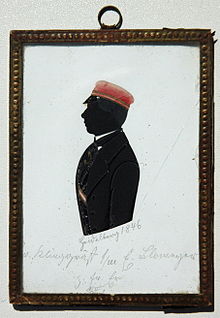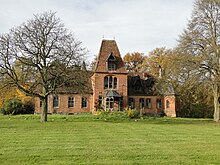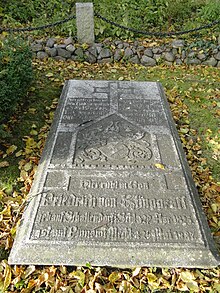Friedrich von Klinggräff
Friedrich von Klinggräff (born April 29, 1825 on Waldgut Schollendorf, Groß Wartenberg district , Lower Silesia; † May 26, 1887 in Pinnow ) was a Mecklenburg landowner and member of parliament. At his instigation, the Kösener Seniors Convents Association (KSCV) was established in 1848.
Life
Friedrich von Klinggräff was the sixth and youngest child of the Silesian landowner Carl Wilhelm von Klinggräff (∞ von Mutzschfahl from Hanover), who inherited the Mecklenburg family estate from his uncle. Friedrich grew up in Mecklenburg and wanted to become an artillery officer. He therefore went to the Realgymnasium Breslau. He was only chosen to study when his father died. Since the visit to the Breslauer Gymnasium was unsuccessful, he moved to the pedagogy of the Francke Foundations in Halle, where he obtained his Abitur. In 1845 he enrolled at the Ruprecht-Karls-Universität Heidelberg .
Corps student
In the first semester , v. Klinggräff at Vandalia Heidelberg , the traditional corps of the Mecklenburg noble families. The soul of the corps was its founder from 1842, later honorary member Dr. iur. Franz Howitz. Klinggräff was reciprocated with Vandalia on December 21, 1845 and fought against Alexander Spengler, among others . His corps brother Alexander von Bülow , who later became Minister of State of Mecklenburg , became a friend . Klinggräff was active for a long time and put together the second batch once and the first batch six times . At the 2nd German Student Congress in Eisenach from September 25 to October 4, 1848, he was the main representative of the entire Heidelberg student body. When he left Heidelberg University in 1849, he became an honorary member of the corps. In 1882 he traveled to Heidelberg with Vandalia's other honorary member Theodor von Holleben and presented a promemoria on corps reforms (alien pumping, duels). He also employed the architect Heinrich Wiethase to build a neo-Gothic corp house (1882, Schloßstrasse 2, east wing). Klinggräff remained closely linked to his corps throughout his life, as evidenced by his nickname "Papa". On May 15, 1848, on behalf of the Heidelberg Senior Citizens 'Convention , von Klinggräff invited the senior citizens' conventions of the German universities to a meeting of deputies on June 10, 1848 at the Rudelsburg . Klinggräff led it and the first congress on July 15, 1848 in the auditorium of the University of Jena .
Squire and MP
As an inactive he went to Gut Chemnitz ( Blankenhof ) near Neubrandenburg . His brother Ludwig von Klinggräff had been a co-owner since 1839. By 1848 at the latest, Friedrich also owned the neighboring Pinnow manor (probably a subsidiary property of Chemnitz).
During the revolution in Mecklenburg (1848) , Friedrich won a state parliament mandate for the constituent assembly of MPs in Mecklenburg, the first freely elected parliament in the state, as a successor candidate in the Ivenack constituency. After the failure of the revolution, he returned to Heidelberg from autumn 1851 to Michaelis 1855 and then moved back to his brother. In 1859 he traveled via Heidelberg to Munich and Nuremberg (visit to the Germanic National Museum ). After that and later he hiked all the important Gothic monuments of the German-speaking area, including Theodoric's grave in Ravenna .
Engaged since autumn 1862, he married Isabella (called Ella) Freiin Langwerth von Simmern (born February 28, 1842 in Wiesbaden ; † August 2, 1918 in Pinnow), the sister of his corps brother Heinrich Frhr, on July 23, 1863 . Langwerth from Simmern . The couple had two children, of whom son Konrad von Klinggräff (1867–1936) later succeeded his father as landowner in Chemnitz and Pinnow.
From the autumn of 1863, Klinggräff was constantly in Pinnow. The mansion where he was until 1869 up to Spucknäpfchen from Cologne diocesan architect Heinrich Wiethase rebuilt in neo-Gothic style romantic - which at that time was unheard of and unique. In 1874 his wife with lung disease moved to Davos. He followed her with the children until spring 1878. In 1875 he fell ill with herpes zoster . In 1886 he traveled to Heidelberg for the university jubilee. After experiencing how his only son Konrad became his corps brother, Friedrich von Klinggräff died after bleeding at the daily house devotion at the age of 62.
Klinggräff adored Martin Luther and was an opponent of papal infallibility . As in his work Patriotic Fantasies , he advocated a moral rebirth of Germany throughout his life.
The manor house in Pinnow has been preserved and has been under renovation since 2012 after it was near ruin. His grave slab has been preserved to this day on a family burial next to the village church in Pinnow.
memory
With the Klinggräff Medal , the Stifterverein Alter Corpsstudenten annually honors young academics who have distinguished themselves through special achievements in studies , corps activities and social work. In 1998 active and old men of the Corps Lusatia visited the dilapidated manor house and laid two crossed thugs on the grave slab in honor of the association's founder.
Fonts
- From the portfolio of a deceased friend, 1891. Klinggräff's correspondence, published posthumously by his brother-in-law and corps brother Heinrich Freiherr Langwerth von Simmern . ( Digitized version )
See also
literature
- Anonymous: Friedrich von Klinggräff. A picture of life . Academic monthly booklet VIII (1892), booklet 95, pp. 454-464.
- Joachim von Rümker: Friedrich von Klinggräff , in: In memoriam! In gratitude to Friedrich von Klinggräff, Ferdinand Ritter von Miltner, Max Meyer and Wilhelm Koch . Once and Now - Yearbook of the Association for Corps Student History Research, Vol. 3 (1958), pp. 142–147.
photos
- 1860 on group lithograph by Corps Vandalia ( Gesell 1860) with Fr. Klinggräff in: Baum, We want men, we want action , p. 67.
- Person lithography v. Klinggräffs as a young inactive with Tönnchen in Einst und Jetzt, Vol. 3 (1958), p. 145.
Web links
- Literature about Friedrich von Klinggräff in the state bibliography MV
- Friedrich von Klinggräff (VfcG)
Remarks
- ↑ The alien pump, the free catering for the gunmen, was often so expensive for the gun protection corps that it had to run into debt. The big problem was solved only after decades by the pressure of old men. See Leonhard Zander
- ↑ The lists of names of the members of parliament from 1848/49 lead him as a landowner on Pinnow.
- ↑ Of the three Pinnows in today's state of Mecklenburg-Western Pomerania, it is about the estate located approx. 11 km west of Neubrandenburg, today a district of the municipality of Breesen . Gut Chemnitz is 3 km further on the B 104 (formerly Amt Stavenhagen, today part of the municipality of Blankenhof ). The two estates had been jointly owned by a family foundation since 1803. The manor house of Chemnitz has been preserved, after 1990 it came into the possession of a Württemberg entrepreneur, it has since (2013) been abandoned to decay.
- ↑ Klinggräff's Gegenpaukant Spengler was a doctor there. See: G. Saul: A corps student establishes Davos' international reputation . Einst und Jetzt, Vol. 28 (1983), pp. 195-202
Individual evidence
- ↑ Kösener corps lists 1910, 122/116
- ^ Chemnitz - history in stories. 2007. pp. 52-54.
- ^ Sabine Bock: Stately houses on the estates and domains in Mecklenburg-Strelitz. Architecture and history , 3 volumes. Schwerin 2007
- ↑ See continuation of the Klinggräff family line. In: Genealogical manual of the nobility. 36: 184-187 (1965).
- ^ Website of the manor
- ^ Egbert Weiß: In memory of Friedrich von Klinggräff. Lusatians visited the home of the association's founder . In: Deutsche Corpszeitung 4/1998, p. 157
| personal data | |
|---|---|
| SURNAME | Klinggräff, Friedrich von |
| ALTERNATIVE NAMES | Klinggräff, Friedrich August von (full name) |
| BRIEF DESCRIPTION | Mecklenburg landowner, founder of the KSCV |
| DATE OF BIRTH | April 29, 1825 |
| PLACE OF BIRTH | Waldgut Schollendorf, Groß Wartenberg district , Lower Silesia |
| DATE OF DEATH | May 26, 1887 |
| Place of death | Pinnow |



